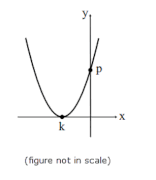fskilnik wrote:[GMATH course practice question]
Points (x,y) in the rectangular coordinate plane such that y = x^2 + mx + (8-m) are presented in the graph shown, where m is constant. What is the value of k+p ?
(A) 1
(B) 2
(C) 3
(D) 4
(E) 5

I am sorry no one contributed (yet), but I hope you all enjoy my solution!
\[? = k + p\]
\[y = {x^2} + mx + \left( {8 - m} \right)\,\,\,\,\,\,,\,\,\,m\,\,{\text{cte}}\,\,\,\,\,\left( * \right)\]
\[k = {x_{{\text{vertex}}}}\mathop = \limits^{\left( \odot \right)} \,\, - \frac{m}{{2 \cdot 1}}\,\,\,\,\, \Rightarrow \,\,\,\,\,m = - 2k\,\,\,\left( {**} \right)\]
\[\left( {k,0} \right)\,\,\, \in \,\,\,{\text{graph}}\,\,\,\,\,\mathop \Rightarrow \limits^{\left( * \right)} \,\,\,\,0 = \,\,{k^2} + mk + \left( {8 - m} \right)\,\,\,\,\,\mathop \Rightarrow \limits^{\left( {**} \right)} \,\,\,\,\,\,\,\,0 = - {k^2} + 2k + 8\]
\[0 = - {k^2} + 2k + 8\,\,\,\,\mathop \Rightarrow \limits^{{\text{Sum}}\, = \,2\,\,,\,\,\,{\text{Product}}\, = \,\, - 8} \,\,\,\,k = - 2\,\,\,{\text{or}}\,\,\,k = 4\,\,\,\mathop \Rightarrow \limits^{k\, < \,\,0\,\,\,\left( {f{\text{igure}}} \right)} \,\,\,\,k = - 2\]
\[\left( {0,p} \right)\,\,\, \in \,\,\,{\text{graph}}\,\,\,\,\,\mathop \Rightarrow \limits^{\left( * \right)} \,\,\,\,p = \,\,{0^2} + m \cdot 0 + \left( {8 - m} \right)\,\,\,\,\,\mathop \Rightarrow \limits^{\left( {**} \right)} \,\,\,\,\,\,\,\,p = 8 + 2k = 8 + 2\left( { - 2} \right) = 4\]
\[? = k + p = - 2 + 4 = \boxed2\]
Reminder:
\[\left( \odot \right)\,\,y = a{x^2} + bx + c\,\,\,\,\left( {a \ne 0} \right)\,\,\,\, \Rightarrow \,\,\,\,\,\,{x_{{\text{vertex}}}} = - \frac{b}{{2a}}\]
The above follows the notations and rationale taught in the GMATH method.
Regards,
fskilnik.

